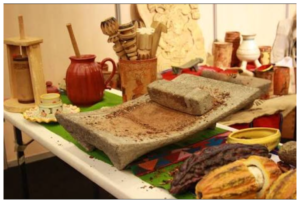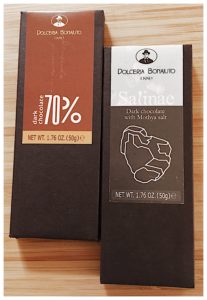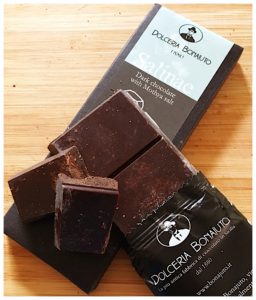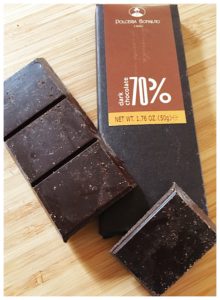30 October 2016
Have you ever wondered how chocolate looked, smelled and tasted, before the advent of complex machinery and processes, and the evolution of scientific knowledge around it? Back to a period in history where chocolate was highly esteemed as an elixir of health, a symbol of wealth and power, and ultimately the “Food of the Gods”?
Admittedly, I had not previously given this much thought. However, a chance encounter led me to discover chocolate, closer to its native form.
 It is widely accepted that chocolate originated from ancient civilisations in Mesoamerica, namely the Mayans and Aztecs. The Aztecs ground cocoa beans into a coarse molten liquid, using a traditional stone grinder called a “metate”. The resultant molten cocoa was mixed with spices and sometime chilli, and consumed as a bitter beverage called xocoatl. When the Spanish discovered the Americas, they took this knowledge back to Europe and modified xocoatl to a sweet beverage by adding sugar.
It is widely accepted that chocolate originated from ancient civilisations in Mesoamerica, namely the Mayans and Aztecs. The Aztecs ground cocoa beans into a coarse molten liquid, using a traditional stone grinder called a “metate”. The resultant molten cocoa was mixed with spices and sometime chilli, and consumed as a bitter beverage called xocoatl. When the Spanish discovered the Americas, they took this knowledge back to Europe and modified xocoatl to a sweet beverage by adding sugar.
Today, the “metate” has given way to varied and advanced methods and tools for chocolate production, used by artisanal and commercial chocolate makers alike. However, one chocolate maker has bucked the trend by choosing to hold on to the traditional method of production, using only ground cocoa beans and sugar as base ingredients, thereby creating an unique old world chocolate experience in modern times.
 At first glance, the chocolate bars of Antico Dolceria Bonajuto, located in the little known town of Modica in Sicily, Italy, are undifferentiated – packaged in plain dark brown boxes with simple, coloured labels and the company logo. But, as I unwrap the chocolate, the difference becomes apparent. The chocolate looks grainy and uneven, like cocoa liquor that has been left to solidify. If I didn’t know better, I’d have thought that the chocolate is “off” or unfinished product.
At first glance, the chocolate bars of Antico Dolceria Bonajuto, located in the little known town of Modica in Sicily, Italy, are undifferentiated – packaged in plain dark brown boxes with simple, coloured labels and the company logo. But, as I unwrap the chocolate, the difference becomes apparent. The chocolate looks grainy and uneven, like cocoa liquor that has been left to solidify. If I didn’t know better, I’d have thought that the chocolate is “off” or unfinished product.
 The aroma is toasty and earthy, like roasted coffee beans. These characteristics come across more prominently in the 80% bar with Mothya salt. As I break off a piece, I note the coarseness of the texture. I can see the fine cocoa nibs and granules of sugar, with the naked eye. I learn that this effect is the result of the chocolate being “cold worked” at a temperature below the melting point of sugar.
The aroma is toasty and earthy, like roasted coffee beans. These characteristics come across more prominently in the 80% bar with Mothya salt. As I break off a piece, I note the coarseness of the texture. I can see the fine cocoa nibs and granules of sugar, with the naked eye. I learn that this effect is the result of the chocolate being “cold worked” at a temperature below the melting point of sugar.
 I put a piece in my mouth and let it melt. The grainy texture on my tongue feels unusual. As it slowly dissolves, the chocolate breaks up into smaller slumps. This is attributed to the absence of the conching process, which further refines the texture of chocolate to what we all associate today with finished chocolate.
I put a piece in my mouth and let it melt. The grainy texture on my tongue feels unusual. As it slowly dissolves, the chocolate breaks up into smaller slumps. This is attributed to the absence of the conching process, which further refines the texture of chocolate to what we all associate today with finished chocolate.
The 70% bar has fruity flavours and, because the sugar crystals are still intact, I get the alternating bitter sweet taste. The 80% bar is more earthy and bitter but, as it dissolves, the Mothya salt starts to bring out the sweetness of the chocolate, leaving a sweeter finish. The lingering after taste from both bars is that of mild bitterness, with toasty notes.
I’m still undecided if I like the taste and texture of ancient, unconched chocolate. But one thing is for certain – I thank the Spanish for their ingenuity in adding sugar to xocoatl many centuries ago, hence paving the way for the evolution of the chocolate that we all love and enjoy today?